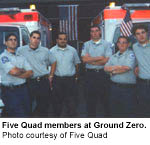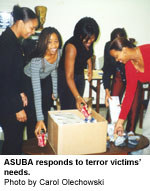
By Carol Olechowski
They come from hometowns throughout New York State, and one in New Jersey. They range in age from 19 to 25. They are sophomores, juniors, and seniors majoring in human biology, criminal justice, chemistry, business, sociology, and history. In a sense, they are a University at Albany microcosm that reflects the diversity of the Americans who rushed to New York City to assist with the search-and-rescue effort in the aftermath of the September 11 terrorist attack on the World Trade Center.
 They are members of Five Quad — six young men who mobilized
September 13 to answer that call at the invitation of the State Emergency
Management Office (SEMO). �We were all very, very eager to go,� said 21-year-old
squad president Dan Banks, a junior. �Some of us have ties to that area.�
They are members of Five Quad — six young men who mobilized
September 13 to answer that call at the invitation of the State Emergency
Management Office (SEMO). �We were all very, very eager to go,� said 21-year-old
squad president Dan Banks, a junior. �Some of us have ties to that area.�
Banks; Five Quad lieutenants Abbas Gokal and Andrew Pavone, both 22; membership officer Matthew Field, 19; and squad members Randall Grant, 25, and Robert Carpenter, 20, left Albany at 8 p.m. the Thursday after the attack. Traveling in a convoy with nine other ambulance corps, including the Western Turnpike Rescue Squad and crews from Cairo and Coxsackie, they reached New York at midnight. Prepared for a 30-hour shift, the UAlbany students set up in a staging area �about 50 feet away from Ground Zero,� Banks recalled in a September 20 interview.
He described the scene as �horrific.� Since the approximately five stories of debris had been secured by military troops, the Five Quad crew members were not involved in the search effort, which went slowly, with rescuers �sifting through [the rubble] using an old-fashioned bucket brigade. The workers didn�t want to use machinery because they didn�t want to hurt anyone� still trapped.
Sustained by coffee — �We only got about two hours of sleep,� noted Banks — the UAlbany students stood ready �to treat anyone who may have been gotten out. For the most part, we provided care to the firefighters and rescue workers for severe burns, twisted ankles, and cuts from metal and concrete.�
No one has been pulled alive from what were once New York�s tallest skyscrapers since September 12. Asked if he and his fellow squad members became discouraged that that was the case, Banks responded: �There was always some hope you would be able to find someone else. Even now, it�s still considered a rescue operation — not a recovery.� Speaking nine days after the attack on the World Trade Center, the sociology major said he was still hopeful that more survivors would be found: �I think there probably are a few people who are still alive. A person can survive for about a week without food, so it�s possible that people are still trapped in there.�
At Ground Zero, the Five Quad team worked side by side with �Americans from all over: Chicago, Buffalo, Los Angeles, Sacramento. It was the most impressive thing I�ve ever seen — extremely well coordinated. Everything went smoothly, and everyone did their jobs� in an atmosphere Banks characterized as one of �dedication.� He added, �Everyone was working so hard; people worked 14 hours straight with very little rest.� The Five Quad crew returned from New York September 16.
One thing Banks will always remember about the experience is �the camaraderie. It was just remarkable that people from all over the country came together and worked together. We felt particularly honored to be able to help out.�
 While Five Quad provided medical assistance at Ground
Zero, members of the Albany State University Black Alliance heightened
their fellow students� awareness of critical material needs at the site
of the terrorist attack, organizing a drive to collect items needed by
both rescue workers and victims.
While Five Quad provided medical assistance at Ground
Zero, members of the Albany State University Black Alliance heightened
their fellow students� awareness of critical material needs at the site
of the terrorist attack, organizing a drive to collect items needed by
both rescue workers and victims.
The inspiration for the effort came when the Red Cross, overwhelmed by the response to the campus blood drive conducted September 12, turned away a number of students. Many ASUBA members had already rolled up their sleeves, but �when we went to donate blood,� recalled ASUBA vice president and criminal justice major Monique Smith, �they [the Red Cross] ran out of blood bags. I felt helpless. I had to do something.�
In fact, later that day, the Red Cross was forced, by the sheer volume of Capital Region donors, to suspend its collections locally, and �told us to go other places,� added Letoria Chambers, a junior who majors in sociology and serves as secretary for ASUBA. At one point, donors who wished to give blood were directed to Red Cross centers downstate.
For ASUBA president Zena Hayes, an economics major, there was also a more personal element to the desire to help fellow New Yorkers: �I�m from Brooklyn. I could see the Twin Towers every day from my window.�
So the 20-year-old juniors banded together and responded to New York City rescue workers� urgent calls for socks, shoes, clothing, bottled water, plastic bags, protective eyewear, paper towels, canned goods, personal items, and razors. ASUBA executive board members Derek Williams, Kevin Mason, Mike Butler, Allen Johnson, Tokunbo Akinbajo, Arlene Payne, Kelli Collins, Galen Gomes, Latia Johnson, Jacelle Gunthorpe, Ronald Edmundson, Sian Martin, and Robert Harrison helped to carry out the drive. Smith contacted the Red Cross for an address where the materials could be sent. Through September 21 — the final day of the collection — the students had collected several boxes of these necessities. �We hope to mail them out tomorrow,� added Hayes.
Martin, a biochemistry major and State Quad captain, was gratified that �people are helping out. We decided to collect money, as well, and we collected between $300 and $500.�
The drive, noted Hayes, �is really bringing everybody on campus together. Everyone is willing to help.�